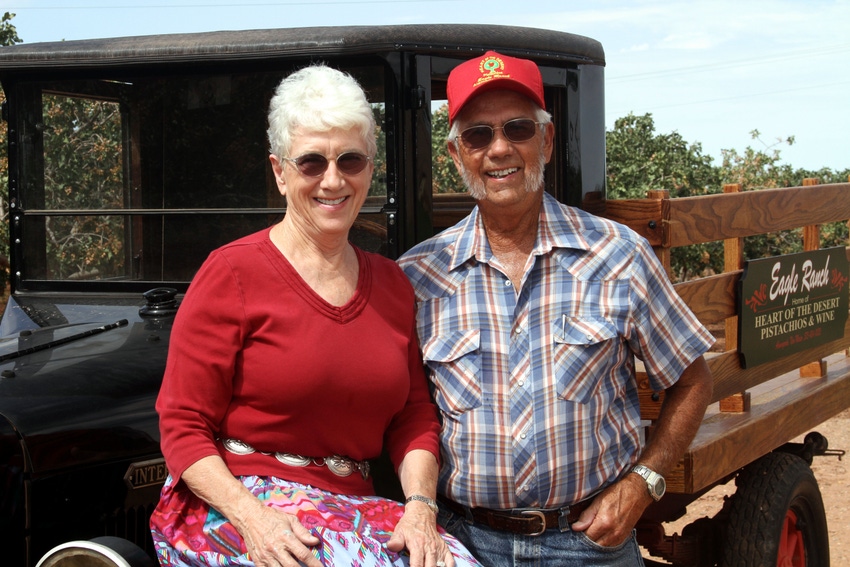
Pistachio production in New Mexico desert different than California
The Schweers interest in pistachios dates back to the early 1970s when George was stationed at the Holloman Air Force Base near Alamagordo, N.M. As he neared retirement from the U.S. Air Force, they considered his post-military options.
August 31, 2016

If you want to learn about growing and marketing pistachios in New Mexico, ask Marianne and George Schweers. They’ve been doing this for 42 years.
Plus, the Schweers produce pistachios under conditions seldom faced by California growers in California who produce 99 percent of the U.S. pistachio crop. Arizona and New Mexico growers account for the balance.
During pollination, George Schweers says westerly winds up to 40-50 miles per hour commonly blow through the tree blocks.
“I like say we help pollinate any pistachio trees growing east of here in West Texas,” George jokes.
Annual rainfall, which can vary considerably from one year to another, seldom totals more than nine 9 inches, he says. Most of the moisture arrives in December and during summer monsoon storms.
2016 has been an unusually dry year. George estimated rainfall by mid-August at two inches max. Even counting the groundwater used to irrigate trees, the Schweers are forced to produce a crop with less water than is normally available to many California growers.
“We didn’t realize when we started, but all along we’ve been farming with deficit irrigation,” George explains. “On average, our wells pump water at about 200-250 gallons per minute (gpm). Sometimes it’s dropped to 100 gpm.
He adds, “Growers in (California’s) San Joaquin Valley tell me they consider anything less than 1,200-1,300 gpm to be a poor well. If we put all our wells together, we might get that much.”
Typically, the Schweers’ water table is recharged by runoff from the mountains surrounding the Tularosa Basin, once the bed of an ancient lake where his trees grow.
“The salinity level of this water is relatively high,” George says. “In fact, about 6-7 miles west of here the water table is only about six feet below the surface and the water is too brackish to support any crop.”
As the crow files, the Schweers ranch is about 10 miles east of the White Sands National Monument.
The hot, dry summers with low humidity result in low disease pressure in the orchards, George notes. Insect pressure comes mainly from stink bugs or leaffooted plant bugs. Depending on the year, an insecticide application may or may not be needed. He’s had no need to spray this year.
Compared to California pistachio yields which can average up to 4,000 pounds of in-shell nuts per year, George considers his yields at 2,000-3,000 pounds per acre “pretty good” for this area.
“However, depending on the year and the soils which can change significantly in quality within a distance of just 10 feet or so, portions of some groves have produced up to about 3,500 pounds per acre,” Schweers said.
Isolated from the mainstream of the industry, the Schweers developed their own infrastructure for crop processing, starting with used equipment to harvest and hull their nuts, and adding custom harvest work to their farming services.
The Schweers interest in pistachios dates back to the early 1970s when George was stationed at the Holloman Air Force Base near Alamagordo, N.M. As he neared retirement from the U.S. Air Force, they considered his post-military options.
The Schweers wanted to remain in the area due to the desert climate and snow-free winters. And, George, who was raised on a 600-acre grain and livestock farm in northeast Nebraska, wanted to farm.
After researching the potential for pistachios as a suitable crop for this region, the Schweers bought a 20-acre plot of land in 1974, where a fellow Air Force serviceman who was being transferred had planted a 400-tree pistachio orchard two years earlier.
Today, the Schweers’ Eagle Ranch encompasses 105 acres of Kerman pistachio trees, plus on-farm facilities to hull, dry, roast, and package the nuts. Their pistachios are sold under the trade name ‘Heart of the Desert’ through four retail stores in the state and their website. Products are shipped throughout the U.S. and overseas.
In 2003, the Schweers began planting a 35-acre vineyard with a variety of red and white grape varietals. Today, they produce and sell 11 different wines under the ‘Heart of the Desert’ label, including Chardonnay, Gewürztraminer, Riesling, Malvasia Bianca, Viva La Roja, Merlot, Corazon Gitano, Syrah, Cabernet Sauvignon, Zinfandel, and Pistachio Rose.
This year, their Gewürztraminer wine won ‘Best of Show’ at the New Mexico State Fair.
Marianne directs the sales and retail operations, while George, who serves as a board member for the American Pistachio Growers, is in charge of orchard and vineyard work.
George has served on the group’s Board since 1990 when the organization was called the Western Pistachio Association.
George typically starts the pistachio harvest around Aug. 25. However this year, relatively cooler weather earlier in the month may have pushed the date back several days.
“For the nuts I’ve opened so far, the quality looks really good with large nuts and nice color,” he says.
Typically, his trees produce from 21-25 nuts per ounce with a split rate of about 75-80 percent. Nuts with enough internal pressure to split open command a higher market value than those which remain closed.
Unlike some California growers who may shake their trees twice to gather earlier-maturing nuts and then later-ripening nuts, George prefers to shake his trees just once.
“We don’t have to cover as much acreage as many California growers do,” he says. “When I’ve tried a two-shake harvest I don’t get enough nuts from the second shake to make it economical.”
You May Also Like



